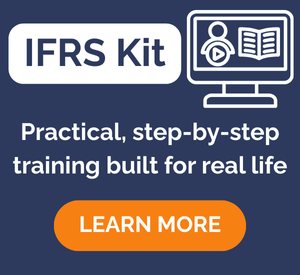IFRS 17 Insurance Contracts: Summary
IFRS 17 was issued in 2017 and is mandatorily applicable for the period starting on or after 1 January 2023. It replaced “temporary” standard IFRS 4 Insurance Contracts, which is no longer applicable. This summary splits the topics covered in IFRS 17 to the following…
Example: Consolidation with Foreign Currencies
Last update: 10/2022 (video added to the end of the article) In today’s world, most groups spread their activities abroad and logically different members of the group operate in different currencies. Is the consolidation process of combining the financial statements of two (or more) companies…
IAS 8 Accounting Policies, Changes in Accounting Estimates, Errors
Updated in March 2023 I bet every single company needed to change something in its accounting records and financial statements. Often, the change is very small, so you just don’t worry about it and make correction on the go. But sometimes, the change can impact…
IFRS 15 Explained: Full Guide on 5-step Model for Revenue Recognition + Free Journal Entries Template
Updated: April 2025 IFRS 15 sets out the 5-step model for recognizing revenue from contracts with customers. This guide simplifies each step with practical examples — including a telecom contract case — plus it includes a free video lecture and downloadable IFRS 15 Journal Entry…
How to account for barter transactions?
How to account for exchanges of inventories or long-term assets under IFRS? Or other barter transactions? Learn here!
Accounting for CAPEX threshold and its change under IFRS
What happens when you buy lots of assets below your capex threshold, but still high expense? And, should you revise your capex threshold retrospectively? Learn here!
Projected Unit Credit Method (IAS 19) with Example
Recently I got across the interesting question. One lady working for a company adopting IFRS for the first time asked me if they can still mark their financial statements as compliant with IFRS, if they do not apply projected unit credit method, but do apply…
Contract Asset vs. Trade Receivable – What’s the Difference?
What is the difference between contract asset and receivable? When to book a contract asset and when a receivable? Learn here (with example)!
How to account for rentals depending on inflation and future sales?
What if your lease payments depend on future sales, inflation, use of the asset, interest rate or other things – what should you do? How should you account for them under IFRS 16? Find out here!
IFRS Reporting in Hyperinflationary Economy (IAS 29)
How to report in hyperinflationary economy under IFRS in three steps: with the video!
Recent Comments
- Saheed Kehinde on How to account for intercompany loans under IFRS
- hassan ali on IFRS 15 Explained: Full Guide on 5-step Model for Revenue Recognition + Free Journal Entries Template
- BiG4 on IAS 23 Borrowing Costs Explained (2025) + Free Checklist & Video
- Mpho on How to present leases under IFRS 16 in the statement of cash flows (IAS 7)
- Silvia on IFRS 18 Explained: Full Guide + Free Video Lectures + Checklist
Categories
- Accounting Policies and Estimates (14)
- Consolidation and Groups (25)
- Current Assets (21)
- Financial Instruments (56)
- Financial Statements (54)
- Foreign Currency (9)
- IFRS Videos (74)
- Insurance (3)
- Most popular (6)
- Non-current Assets (56)
- Other Topics (15)
- Provisions and Other Liabilities (46)
- Revenue Recognition (27)
- Uncategorized (1)












